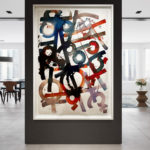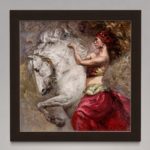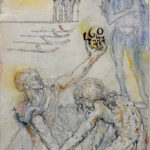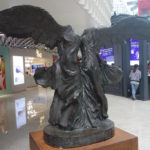
From time to time I’ll use this blog to feature interviews with professionals that serve key roles in the fine art community. International art dealer Reed V. Horth of Florida was kind enough to answer questions for a two-part interview. Part one dealt with questions for artists; below is part two which answers questions for art collectors. Enjoy!
–
 Please describe what you do and how you help collectors find the perfect artwork to add to their collection.
Please describe what you do and how you help collectors find the perfect artwork to add to their collection.
My particular role as a Fine Art Concierge often involves collectors telling me what artwork they want. This is sometimes a more clinical process than the pure, visceral feeling of buying artwork at a show, auction or gallery. This being said, I present a broad spectrum of artists, works, price ranges and media to them, then gauge their responses trying to find out their feelings whether positive or negative. I ask questions, and I listen to their answers. I do not try to fit a round peg into a square hole. Just because I have a work does not make it perfect for them. Perhaps there is another work or artist that suits them perfectly. That is the piece I want to find for them.
Do you advise your collectors to purchase for “pleasure” or for “investment”?
In this day and age, no one purchases anything they ostensibly do not need without thinking long and hard about it. I do not advocate Art being bought specifically “to make money”. That being said, art has much more solidity than many of the more “safe” traditional investment vehicles. I doubt many investment advisors were prescient enough to know that their “safe” investments would be selling at roughly half their value presently.
I believe that all art, no matter what the price, should be purchased for pleasure (whatever “pleasure” encompasses for you… pride, imagination, tranquility, lust, money, inspiration, discomfort, etc.) At prices under $5,000, collectors may buy without a reasonable expectation of monetary returns on that purchase. At about $10,000 the mentality shifts to a more pragmatic mode where collectors may desire some form of appreciating asset.
What documentation should accompany a piece of artwork so a buyer can prove authenticity if they decide to sell the piece later?
Generally, a writ of sale (i.e. a purchase order, invoice, or letter of origin) should accompany any fine art purchase. If the artist chooses, they may issue a “Certification of Authenticity” which certifies this work as being by their own hand. As their sphere of influence grows and there is more of a risk of duplication and/or fakes surfacing on the market, these Certifications become even more important. If an artist’s work is distributed by a publisher, the publisher will issue these certifications.
Additionally, artists should sign their works and keep an inventory of the works they have produced in their career. I would encourage them to give each work a reference number. Artists should know the date, name, size, media, consignment date, sale date and end user name (Oftentimes this is the gallery, and the gallery is not under any obligation to tell you the buyer’s name, although they may) This lineage establishes provenance so that an artist can retrace steps if and when there is a question of authenticity, or when a catalogue raisonne is prepared.
When a collector sells an original piece of artwork from their collection, do they have any responsibilities to the artist who created it? For example; reporting the sale, paying the artist a percentage of the profit, etc.
No. Once the artwork leaves the artist’s hands, the ownership rights are handed over. While Artists do maintain their copyrights to prohibit unauthorized reproduction, they do not have claim to any profits from sales.
(Note to readers: in the U.S. only California recognizes Resale Rights for artists. For more information do an internet search for “California Civil Code Section (§) 986”)
Many people who would like to become art collectors or learn more about art in general express a feeling of “intimidation” about the subject. Have you run across this sentiment before and if so, can you explain where you think it might come from?
Art is somewhat of an intimidating subject because we all feel that we “should” know more about it than we generally do, kind of like fine wines. There is a tendency to want to know about different varietals and appellations, but few of us will take the time or effort to discover the nuances that differentiate one bottle from another. It becomes more and more daunting because there is such a massive amount of information to disseminate. This is why dealers, artists, experts, clients and those who work in the arts oftentimes will specialize in one genre, era, style, artist or movement.
What qualities should novice collectors look for in a good art consultant or gallery? Should an art dealer have a long history in the arts arena?
Good dealers will make certain that customer service is such a focus that the sale will not be a one-time occurrence, but a long-term relationship that can be nurtured. Clients want to be loyal and come back to their comfort zone. It is difficult to gain this trust and all too easy to lose it from one bad piece of advice.
Great dealers do not always have backgrounds in Art, but most possess some degree of knowledge and can balance passion for the Arts with a pragmatic business-sense. I have seen dealers who know very little about Art or its history, but are gifted salespeople and marketers. Conversely, I have seen salespeople who are so knowledgeable that they bog clients down in Art minutiae and bore prospects out of buying. A balance between the right-brain and the left-brain must be struck.
But, my primary criteria for a person I work for or with is “respect”. I feel that everything we do in life boils down to this concept. Respect for oneself, for others, for time, for your business, for your contracts, for Art in general and the artists and clients you represent in particular. Respect in all things is paramount.
Name two or three of the biggest mistakes first-time art buyers often make.
Many buyers think that they are instant experts because they Googled something. They will develop a picture in their head of how things are based on half-truths and innuendo. As with everything, we must take information with a grain of salt. Consider the source and remember that your research is cursory at best. Simply reading a few articles about art cannot substitute for an expert’s years of experience.
Buyers should also understand that reading auction figures only provides one minute cross-section of the pricing spectrum. The criteria being measured may or may not be based upon the same criteria with which you are dealing. Auction cycles, time, location, other items being offered and rarity are some of the myriad factors at work in an auction price. Some prices are anomalies and should not be taken as indicators of the market as a whole.
Are there any factors that make one particular piece of art more worthy of collecting in comparison to another?
I see a confluence of factors including being in the right place at the right time, rarity, speculation and being first or the last of a trend or series. There is not a tried-and-true, fool-proof method of determining which works are more important than others, but typically your gut will give you a good indication on whether or not the work you are obtaining is worthy of what you are paying for it.
Is there any type of work that you would advise clients against buying? If so, please explain why.
I advise clients not to buy works all the time. If it is over-priced or there is ambiguity in the documentation on a work or if has not been properly vetted by third-party experts. Your role as a dealer should be to advocate the best possible advice for your clients. Sometimes it is not in their interest to buy a particular work at a particular time. Sometimes it is in their interest to tell them to avoid it altogether. This is how you build trust with a client. Not merely seeking their hard-earned cash, but truly having their interests in mind and doing the best job you can for them.
Can you elaborate a bit more on what you mean by “vetting by third-party experts”? Who are these experts and what is the vetting process?
Depending on the artist, age, type, size and scale of the transaction dealers and/or clients will call in independent, third-party experts to verify the veracity of the information provided and transactional aspects. Third-party experts are generally dispassionate observers with no vested interest in whether or not money changes hands as they have no stake in the transaction’s completion, only in denoting their expertise as it relates to the work itself.
These third party experts include, but are not limited to: Appraisers, authenticators, attorneys, import/export officials, police and investigatory officials (who investigate a work’s clearance on the international market) and title insurance advisors (to ensure a work is available to be sold without title encumbrances).
Dealers do not necessarily serve in this capacity as there may be a monetary motivation preventing them from complete neutrality in the process. Not to insinuate that dealers cannot compartmentalize, but experts should primarily not have a buying and/or selling interest thereby ensuring no bias.
What should collectors know about copyright laws? For example; a collector buys a painting and would like to have the image scanned and placed on a mug, is this acceptable use of the purchased art?
Collectors purchase no copyrights whatsoever when they purchase a piece of artwork. If they wish to reproduce the artwork in any way, shape or form, they must obtain explicit written permission from the artist or copyright holder (sometimes this is the publisher) to do so. Copyright attorneys will be able to expound of the legal jargon behind this assertion a bit more fully, but if you are in doubt about whether or not you can…. you probably can’t.
Have you noticed a big difference between the American art market in comparison to the European art market?
Over the past several years the disparity between a weak US Dollar and the EURO and British Pound has caused many more Europeans to purchase high-end commodities in the United States. Exchange rates trading at over 2/1 caused British buyers to frenzy to the US to snatch up undervalued properties, art, gold, silver, diamonds, etc. The recent weakening of both currencies has curtailed much of this spending, but many investors still feel that they can milk the boom for a bit longer.
Tell a little bit about how you came into your line of work and where curious art lovers can go to procure your services.
I started in the Art business in 1997, and established ROBIN RILE FINE ART (www.robinrile.com) at the end of 2008. My passions and studies have always been focused on art. Once I realized my talents lay more in Art promotion and writing than production, I found my niche. That forte is in locating rare blue-chip investment-level works for high-end clientele. Through research, tenacity and connections many unbelievable deals can be located for investors right now. Oftentimes, I will receive very strange requests (Like one gentleman who wants a full-scale example of Auguste Rodin’s “Bourgeois du Calais”). But mostly they will ask for a blue-chip artist in a given price range.
I also really like to work with and mentor young talented artists. While I cannot work with everyone, I love to help artists establish themselves as professionals, make their passion their career, and develop long-term strategies which can build their reputations and oeuvre. It is a privilege to deal with such talent. I am humbled by it and will never take it for granted.
–
Thanks Reed!
Further information:
S. C. Versillee has been creating images since the age of three and under her mother’s early tutelage she honed her craft, developing a life-long love and respect for the arts.
A contemporary realist painter who works primarily in oils, Versillee sold her first painting at the age of 16 to a local shop owner and participated in her first group show at the age of 18. She has been juried into various distinguished fine art exhibitions including, the Catharine Lorillard Wolfe Art Club and the National Oil and Acrylic Painters Society’s “Best in America” annual show. She has appeared in both print and media and was included in a 2006 book, “Painter: The World’s Finest Painter Art”. Currently she has collectors of her figurative works throughout the United States. Some of Versillee’s other interest include creative writing, web design and research on the subjects of anthropology, symbolism and myth.
S. C. Versillee earned a Bachelor’s Degree in Art from the Cleveland Institute of art in 1999 and a Master’s in Library and Information Science from Kent State University in 2005. She currently works and lives in North East Ohio. She is an associate member of the International Guild of Realism and Oil Painters of America. http://www.scversillee.com/





